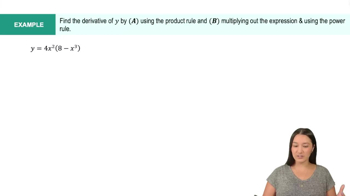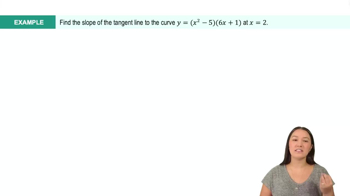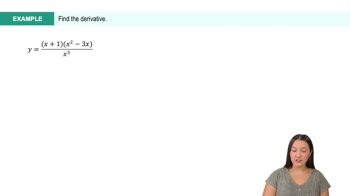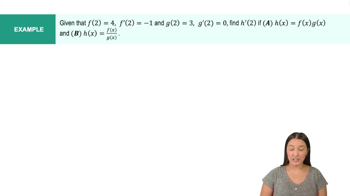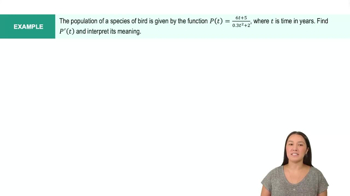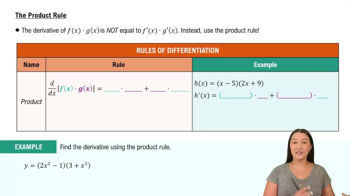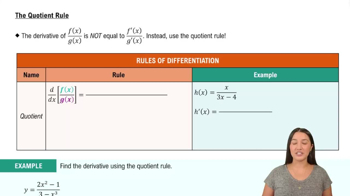Table of contents
- 0. Functions7h 52m
- Introduction to Functions16m
- Piecewise Functions10m
- Properties of Functions9m
- Common Functions1h 8m
- Transformations5m
- Combining Functions27m
- Exponent rules32m
- Exponential Functions28m
- Logarithmic Functions24m
- Properties of Logarithms34m
- Exponential & Logarithmic Equations35m
- Introduction to Trigonometric Functions38m
- Graphs of Trigonometric Functions44m
- Trigonometric Identities47m
- Inverse Trigonometric Functions48m
- 1. Limits and Continuity2h 2m
- 2. Intro to Derivatives1h 33m
- 3. Techniques of Differentiation3h 18m
- 4. Applications of Derivatives2h 38m
- 5. Graphical Applications of Derivatives6h 2m
- 6. Derivatives of Inverse, Exponential, & Logarithmic Functions2h 37m
- 7. Antiderivatives & Indefinite Integrals1h 26m
- 8. Definite Integrals4h 44m
- 9. Graphical Applications of Integrals2h 27m
- 10. Physics Applications of Integrals 2h 22m
3. Techniques of Differentiation
Product and Quotient Rules
Problem 66b
Textbook Question
Population growth Consider the following population functions.
b. What is the instantaneous growth rate at t=5?
p(t) = 600 (t²+3/t²+9)
 Verified step by step guidance
Verified step by step guidance1
Step 1: Understand that the instantaneous growth rate of a population function p(t) at a specific time t is given by the derivative of the function, p'(t), evaluated at that time.
Step 2: Identify the given population function: p(t) = 600 \left(\frac{t^2 + 3}{t^2 + 9}\right).
Step 3: Use the quotient rule to differentiate p(t). The quotient rule states that if you have a function in the form of \(\frac{u(t)}{v(t)}\), its derivative is \(\frac{u'(t)v(t) - u(t)v'(t)}{(v(t))^2}\). Here, u(t) = t^2 + 3 and v(t) = t^2 + 9.
Step 4: Compute the derivatives u'(t) and v'(t). For u(t) = t^2 + 3, u'(t) = 2t. For v(t) = t^2 + 9, v'(t) = 2t.
Step 5: Substitute u(t), v(t), u'(t), and v'(t) into the quotient rule formula to find p'(t). Then, evaluate p'(t) at t = 5 to find the instantaneous growth rate.
 Verified video answer for a similar problem:
Verified video answer for a similar problem:This video solution was recommended by our tutors as helpful for the problem above
Video duration:
4mPlay a video:
Was this helpful?
Key Concepts
Here are the essential concepts you must grasp in order to answer the question correctly.
Instantaneous Growth Rate
The instantaneous growth rate of a function at a specific point is determined by the derivative of that function at that point. It represents how fast the population is changing at that exact moment in time, providing a snapshot of growth rather than an average over an interval.
Recommended video:

Intro To Related Rates
Derivatives
A derivative is a fundamental concept in calculus that measures how a function changes as its input changes. It is defined as the limit of the average rate of change of the function as the interval approaches zero. In the context of population functions, the derivative gives the rate of change of the population with respect to time.
Recommended video:

Derivatives
Population Functions
Population functions model the size of a population over time, often using mathematical expressions that incorporate variables like time. In this case, the function p(t) = 600(t² + 3)/(t² + 9) describes how the population changes as time t progresses, allowing for analysis of growth patterns and rates.
Recommended video:

Properties of Functions
Related Videos
Related Practice



